Being an amateur photographer (not an architect at all), I prefer to bring original material to this blockchain, such as my own photographs. But I'm really obsessed with history and historical photos of the life that have gone a long ago, and my city of St.Petersburg in particular. I have accumulated a huge pile of interesting black and white stuff I would love to share ... but I am not its author! therefore, as a rule, I dont hold my breath and all the stuff just wait quietly :)
Today I will make an exception: firstly, in order to support the community together with the #OCD, and secondly ... I have long been going to tell a story about the Moscow Triumph Gates at St.Petersburg: I have my own photographs, and I really can tell an interesting story about it. Afraid that even a few posts will not be enough for this! So, Part one | Part 2 | Part 3 | Part 4. Russian version will follow, as well.

So ... where should I start? I live in the neighborhood, I often find myself at this location, every time I go to the city center, or pay a visit to my publisher, I pass by the Gates and admire ... and of course I take photos :)
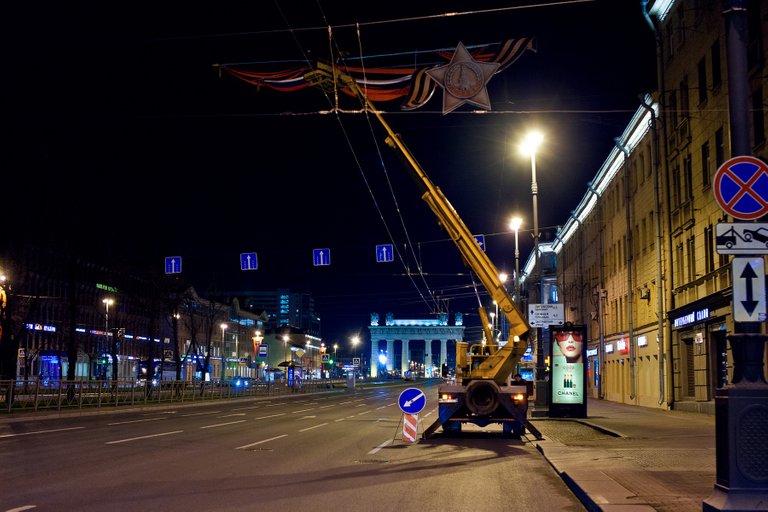
All of them are very different. This one was 1st published at Steemit blockchain back in 2019, before the HIVE was born and before C-19...
It is a key point on the city map, within its infrastructure; like the Japanese Fujiyama, which is known for its "24 views from different angles" series. Nowadays it is not the last street in the city - it leads to Pulkovo airport, this is the first thing that tourists and guests of the city see. In the 18th century, it was city's edge, the Obvodny Channel located nearby, marks the formal border of the "historical part of the city" today.
Until the middle of the 19th century (the time when emperor Nikolas I railway have appeared), it was the most important trade and passenger route connecting the capital with the central regions of Russian empire and Moscow. A wide variety of carriages, postal coaches, stagecoaches, carts and long carts loaded with all kinds of goods filled the wide and very comfortable road. A huge number of cattle were driven here to the stockyard as well. Here was the entrance to the city and the customs checkpoint. The need to organize the area was obvious, and in 1838, during the reign of Emperor Nicholas I, the Triumph Gate was erected here.

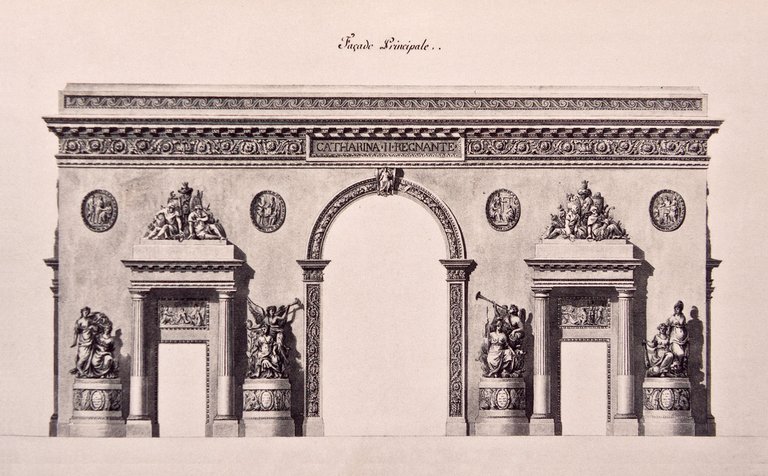
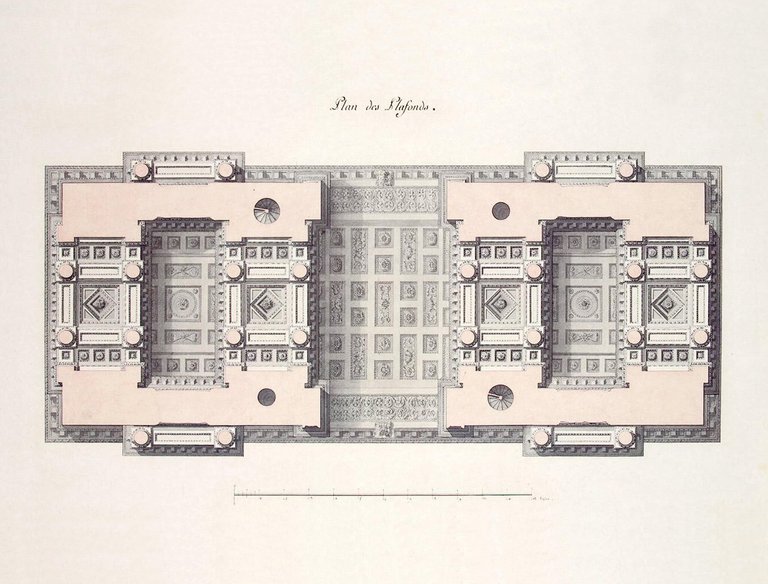
50 years earlier, Empress Catherine II was delighted with the drawings of the French architect Charles-Louis Clerisso and commissioned him to design the Gate. She enjoyed his work, but it was not accepted due to its high cost.
Project Clerisso (1780; drawings and the author's model have been preserved and kept in the Museum of the Arts Academy).In 1831, Albert Kavos developed the project of "Victory Square" (dedicated to the victory in the Russian-Turkish War of 1828-1829). It contained a three-span triumphal arch, a beautiful square with several monuments and a Doric colonnade connecting this ensemble with the city. His project was not implemented for the same reason: it was too expensive! By the year 1832, the project of another famous Russian architect V.Stasov, more budget-friendly, won. Stasov based his project on the Athenian Acropolis Propylaea. The order of the columns, the utmost simplicity and logic of composition put the Moscow Gate on a par with the great examples of the art of ancient Hellas.

Propylaea of the Athens Acropolis.
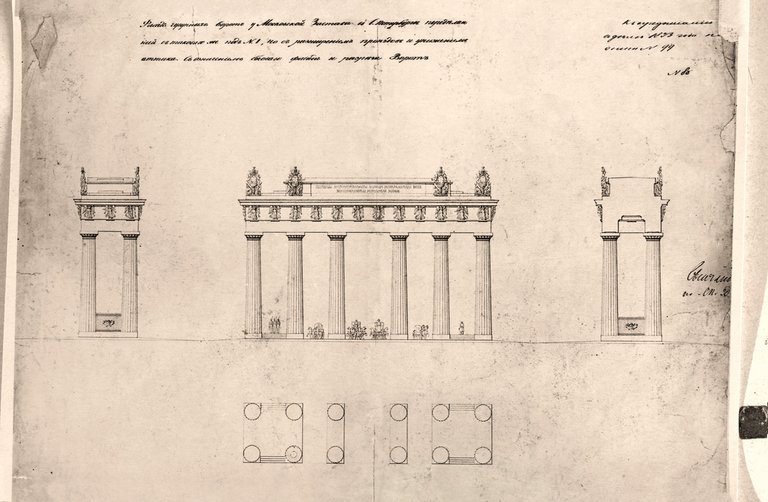
V. Stasov's project (1832). GIOP Archive (State Inspection for the Monuments Protection).

The Gate received an original and successful sculptural design: Stasov replaced the geometric pattern of the Doric entablature with figures of geniuses, sculptural details became an integral part of the composition. Above eight columns, Stasov placed "fittings" made of military armor (aka 'armatura'. 'armament'). This gave the Gate's silhouette a great solemnity and pathos. The sculptures' models were created by B. Orlovsky, one of the best Russian sculptors of the first half of the 19th century.
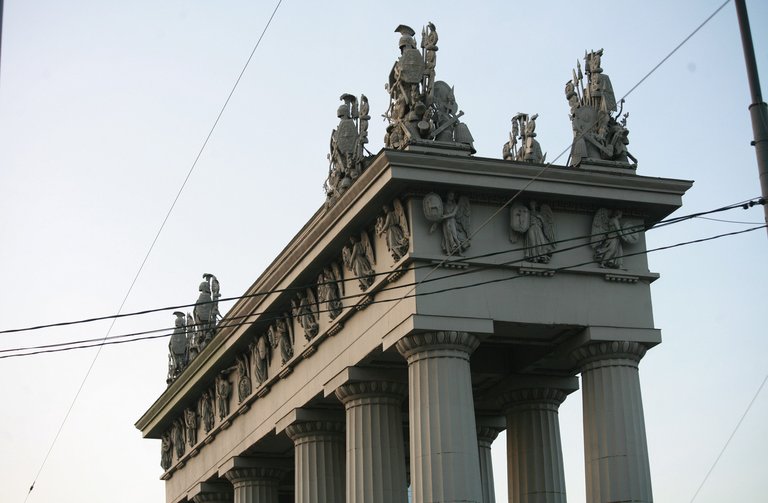
Below some of my Gates' sculpture decorations captured during 2011-2017 years, copyright (c) @qwerrie
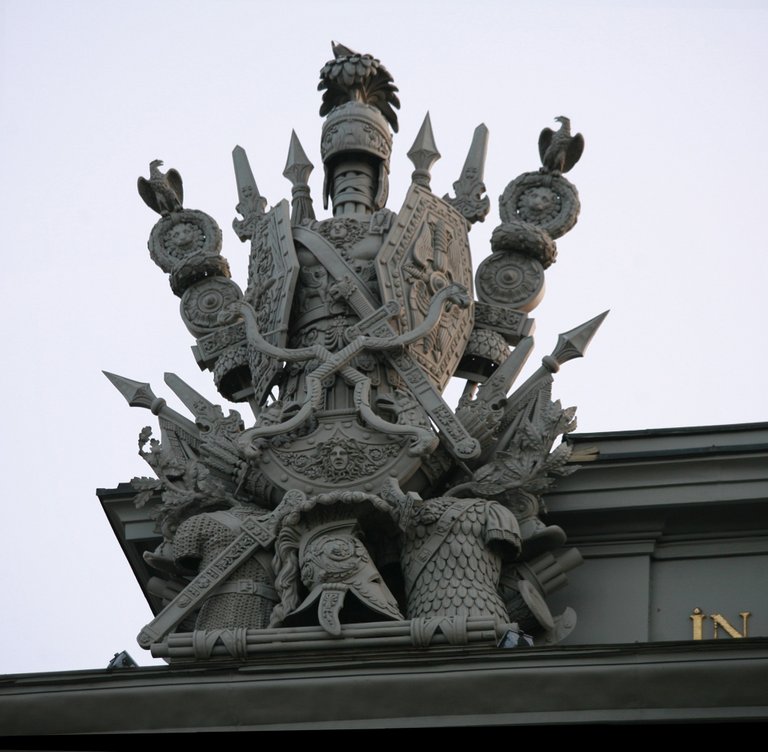
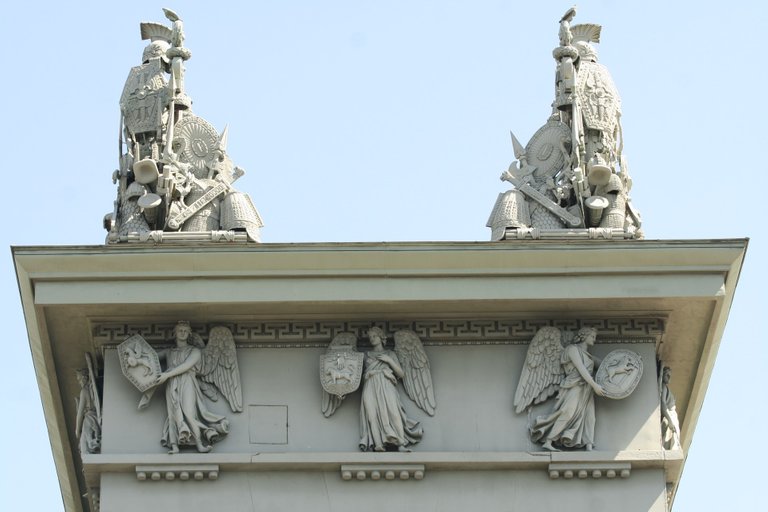
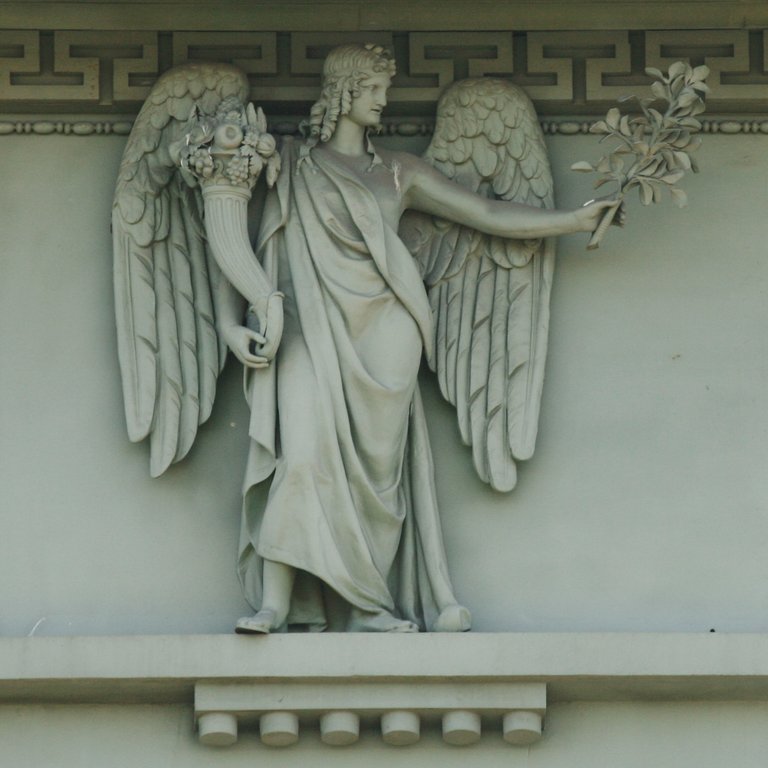

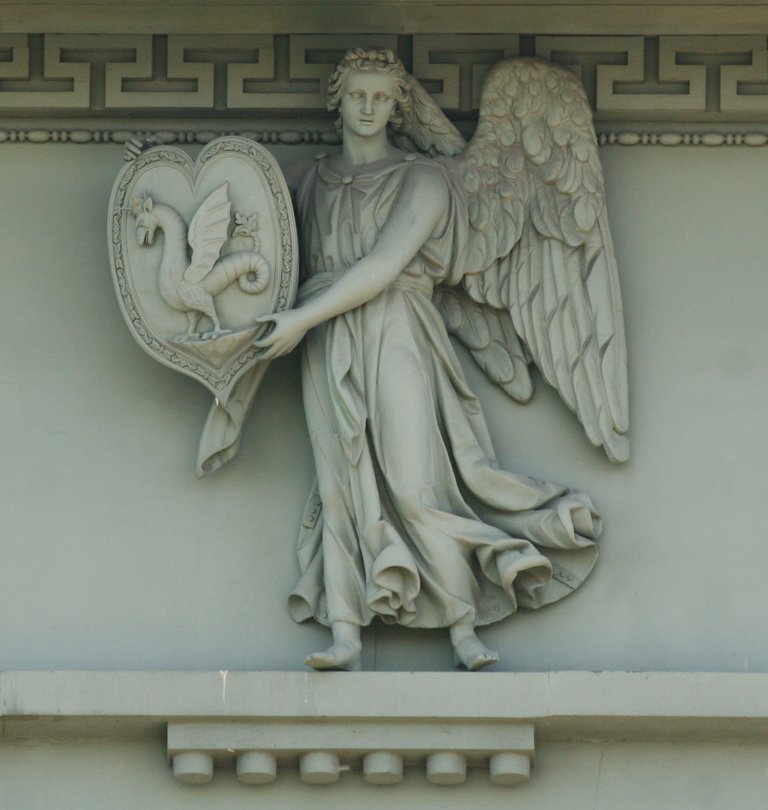
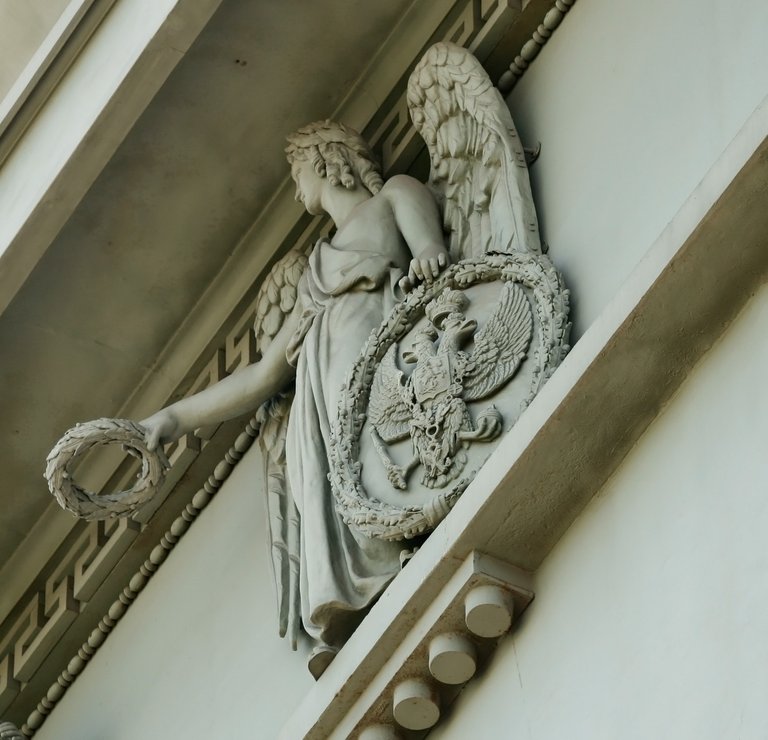
The Moscow Triumph Gate is the world's largest architectural structure made of cast iron, it is of great technical interest and it is a monument to the skill of Russian foundry workers. Casting and installation of the Gate was carried out by the state-owned Alexandrovsky iron foundry (casting of all parts was completed in the spring of 1837, after that installation and finishing began). Whole project costed 1,108,000 rubles (of which the pure foundry work amounted to 760,000 rubles). All works took 6 years, from 1833 to 1838.
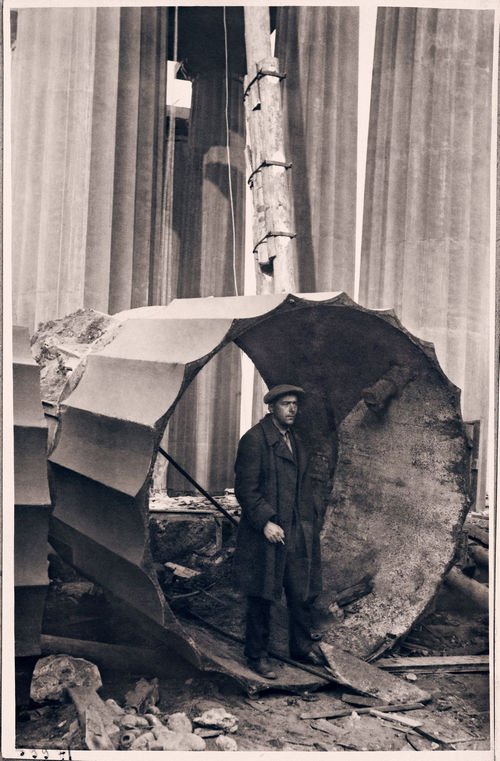
NB. I am getting a response in comment section, which makes me understand I missed to single an important nuance: the Gates were made of 'cast iron', not an 'iron', this is a bit different thing. Also, note the columns are mountable, hollow inside. One of the columns even had a staircase to the top, which used to serve as the observation deck in the past... I will write about it in more detail later.
Below is the photo from 1931, I am ruining the chronology here, but obviously I dont have any suitable illustrations from 1837 to put them here, hehe!

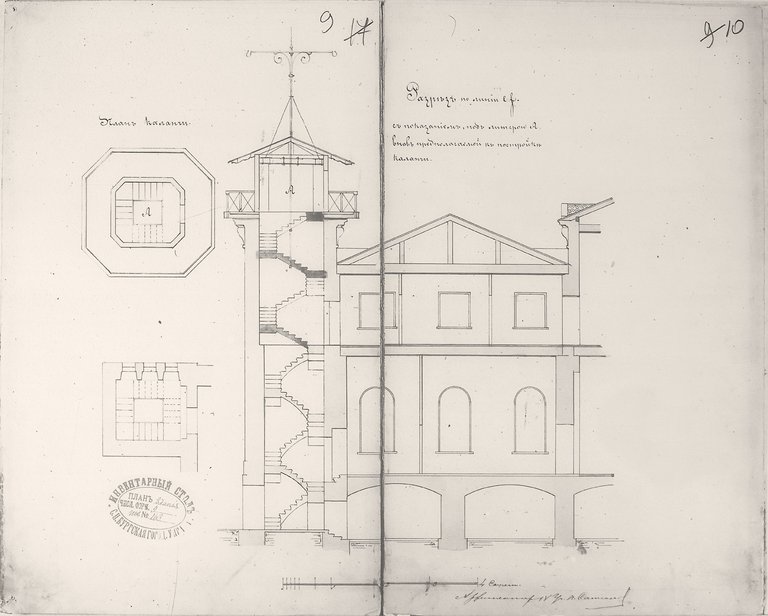
An integral part of the architectural ensemble conceived by Stasov were two "guardrooms" houses, aka 'Kordegardia' (premises for the guards of the fortress gates, from the French 'corps de garde').
Plans, intersection of the guardhouses that make up the Gateway ensemble.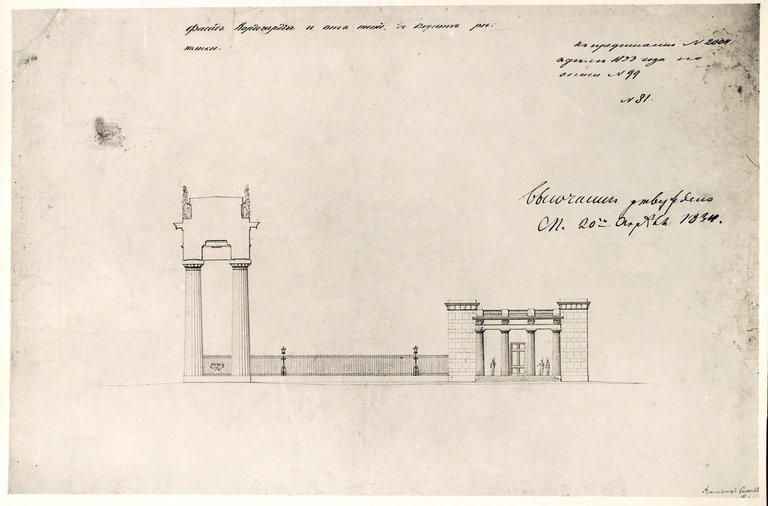
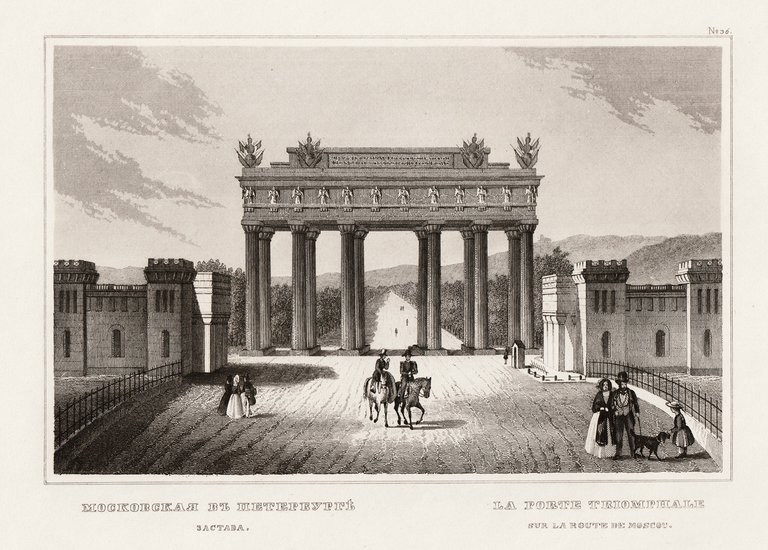
One of the first images of the Gates: an engraving by Charlemagne, circa 1850. View in the direction from the city. A linden alley is visible on both sides of the tract.
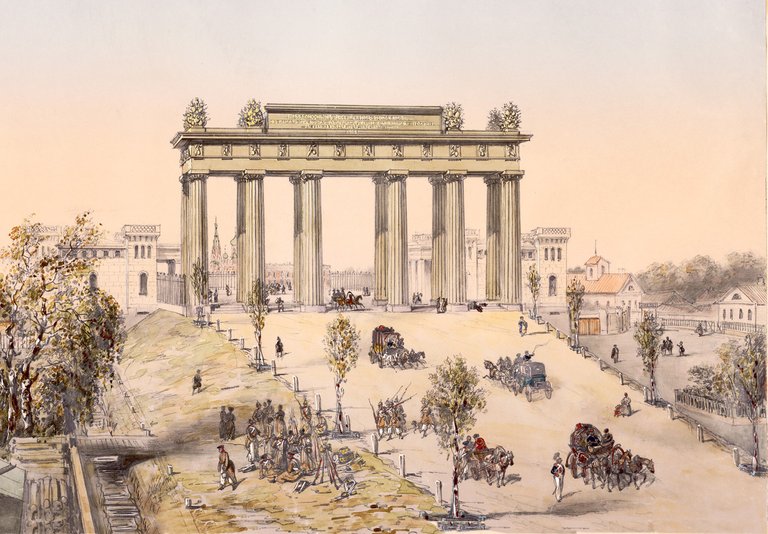
Charlemagne watercolor (1853), view towards the entrance to the city; two guardhouse houses are on the left and right.
And the routine everyday life began. This wasnt city's parade fashionable district. By the end of the 19th century, the usual poor working-class outskirts, taverns and brothels were known to exist here in large numbers, the nearby Ligovskaya Street became a famouse criminal center of the city. Veterinary station, cattle yard, horse tram terminal.
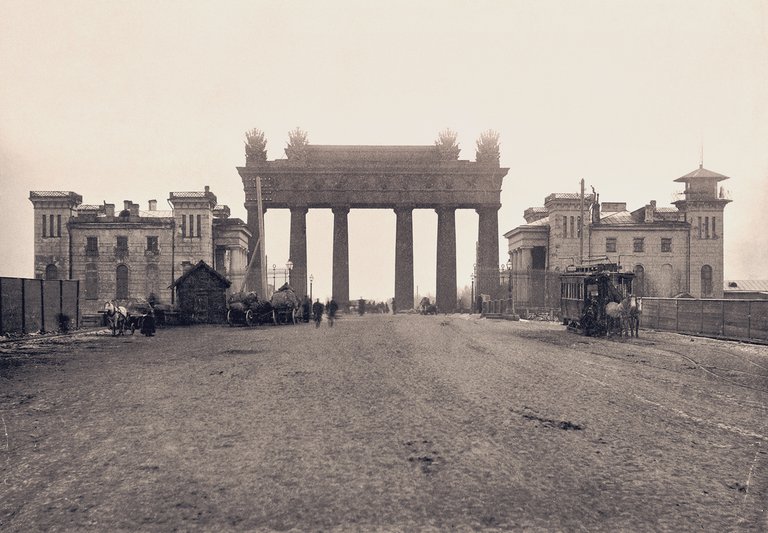
Terminal of the horse tram. Photo by Karl Bulla. Circa 1900-es.
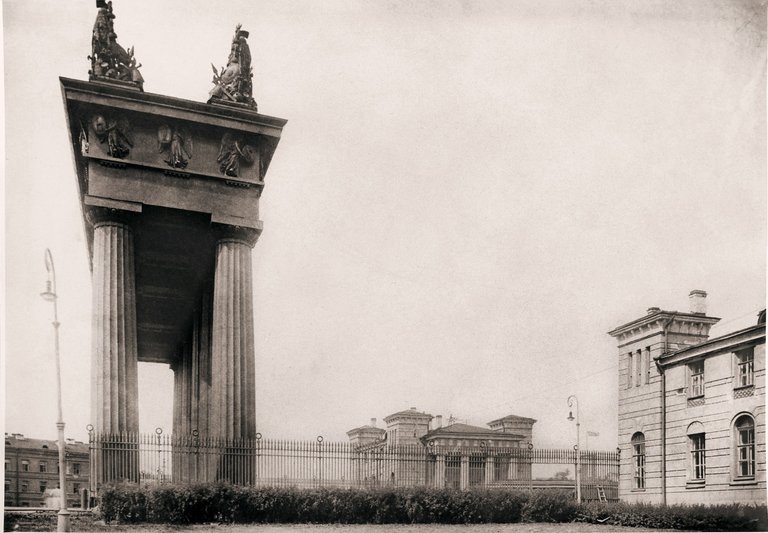
Russia was making a giant leap forward into the twentieth century, the city was modernizing and expanding non-stop. Soon it will feel very cramped in these narrow patriarchal frames - and in a few decades these pictures will remain only in memory - and on the photo paper. To be continued!

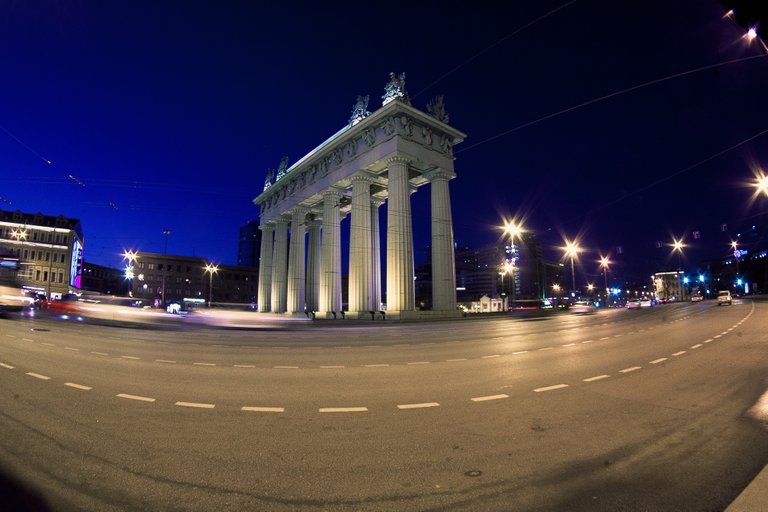
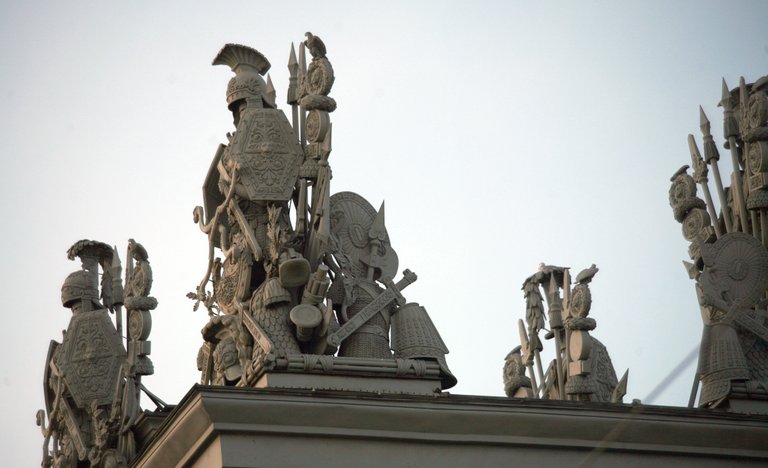
Wonderful blog @qwerrie!
I find history fascinating, and am especially interested in the story of the last Russian Czar Nicholas and his family. I inherited all my late uncle's books on them and one in particular has stunning photos of the Winter palace in St Petersburg. Do you visit there at all?
But I'm digressing, your post is fabulous, those statues on the gate is real works of art, so intricate, something to be very proud of!
o-oooh! thats a pleasure to hear for me, seems we both share this passion
I just released today the part 2 of the story, and not sure if I will be able to write part 3 in the next 2 days... but parts 3 and 4 will be written, sooner or later! this is a load of vintage photos and a long story. part 3 ould be a sad one, dedicated to their demolition by bolsheviks.
well, what can I say - back in 1990-es, probably all of us, 95% of Russia's population were heavily intrested in that! including myself.
I dont have a lot of photos of Nicholas 2 and his family - I enjoy them very much but dont collect on intention just for their own sake. hehe. some of them are quite intresting, tho. and there exist a very intresting extremely intresting photo collection of Prokudin-Gorsky, let me acquaint you with this name...
ofc I have been to the Winter Palace - its the top, #1 state museum of Russia. I am sure if you happen to visit Russia one day - you will choose the city of St.Petersburg, them visiting Hermitage will be inevitable :)))
tho I cant say I visit it too often... very rarely, to tell the truth. I wish I could change it, tho....
!ENGAGE 30, thank you very much for visit. and next time! this A+D community should become a flourishing place for elite hiveans !! :-)
ENGAGEtokens.View or trade
BEER.Hey @qwerrie, here is a little bit of
BEERfrom @pixresteemer for you. Enjoy it!Learn how to earn FREE BEER each day by staking your
BEER.How are you dear friend @qwerrie good night
I call this an excellent post, I appreciate all your time researching the information, you are not only an excellent photographer, you are also a good historian
Thank you very much for the beautiful images and the excellent information
have a great night
Mindblowing
Congratulations, your post has been added to Pinmapple! 🎉🥳🍍
Did you know you have your own profile map?
And every post has their own map too!
Want to have your post on the map too?
Hello @qwerrie, this is a great example of an architectural structure present today that tells an interesting story of how it came to be and how it evolved along with its surroundings. Welcome to the Architecture + Design Community!
thank yoy, gla you like it. 'how it evolved along with its surroundings.' -- this was only 1/3 of the way, most dramatic part yet to be told..
oooh..wonder what happens and where you will be taking us next.
next is their demolition by bolsheviks, of course.
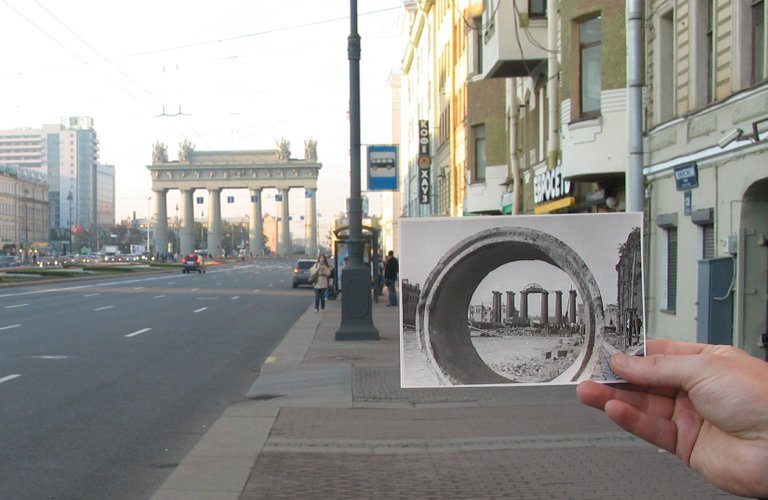
(see the pic)
the tragic page of their history
Cool before and after shot
it was possible to locate (I guess) the same point where that old photo was taken. a fun venture!
You've done a great job my friend @qwerrie!
Many times I have passed and passed by these gates, but I did not think that they were cast from steel.
We are waiting for the continuation :)
Ты славно потрудился, мой друг
Много раз я проходил и проезжал мимо этих ворот, но не думал, что они отлиты из стали.
Ждём продолжения
не, не из стали - чугун! внутри они полые и разборные.
современные воротам источники утверждают, что будь они сделаны из камня, суммарный вес конструкции оказался бы в 5 раз больше.
..а ты знал, что до 60-го года Ворот в городе не было?..
в войну разобрали?
Не не знал
не в войну. ну, я напишу, кратко, почитаешь. тема интересная!
ok)
Congratulations @qwerrie! You have completed the following achievement on the Hive blockchain and have been rewarded with new badge(s) :
Your next target is to reach 15000 replies.
You can view your badges on your board and compare yourself to others in the Ranking
If you no longer want to receive notifications, reply to this comment with the word
STOPCheck out the last post from @hivebuzz:
There's a great history behind these structures. great post :)
Wow @qwerrie, I loved reading your post and the photos are extra 👏 Beautiful decoration sculptures!!
Made of iron? I wouldn't guess that...
made of "cast iron", its not the same as iron.
look at the pic:

the columns are collapsible, they are hollow inside. one of them even has a staircase to the top, to the observation deck ... but I will write about this in more detail later. in general, it was only 1/3 of the story. the most dramatic events in their lives, and the happy ending is still far ahead!
Oh, hollow inside, now it is even more interesting 😎
Thank you @qwerrie, great dedication and work you did here!!
aha! my greatest pleasure, great you appreciate this historical stuff :D
let me treat you with !WINE?
Cheers @qwerrie, Thank You For Inviting @mipiano To A Glass Of WINE.
At The Moment You Don't Have Enough WINE Staked To Order A Glass Of WINE From @wine.bot.
Please Refill Your Barrels By Directly Buying WINE From Marketplace & Make Sure You Have Atleast 25.00 WINE In Staked Wallet.
Total Purchase : 20812.923 WINE & Last Price : 0.290 HIVE
HURRY UP & GET YOUR SPOT IN WINE INITIAL TOKEN OFFERING -ITO-
WINE Current Market Price : 0.290 HIVE
Yes, I like both architecture and history...and your photos 😇
And you know that you don't have enough wine staked, right? I don't have either 😬😂
But the invitation counts the same ☺️🍷🥂
I think emitter of a token changed the rules of the game, again. as always.
time
to buy moreto sell my tokens, then. heh. but I can share with you !BEER, tho its not the same as delicate dry red wine, of course.. you know.😇
you are heaven sent, @mipiano! I may only add to this list 'old dusty papers' that I love myself :P
Old dusty papers...like old dusty piano books in my case :D
Yes, the wine changed the rules, one has to buy the tokens and then can share it. My husband bought them, I didn't.
View or trade
BEER.Hey @mipiano, here is a little bit of
BEERfrom @qwerrie for you. Enjoy it!Learn how to earn FREE BEER each day by staking your
BEER.Welcome @qwerrie to Architecture + Design Community!
Please feel free to check out community comprehensive guidelines .
The Architecture+Design Community is an Active Member of the OCD Communities Incubation Program
my biggest pleasure!! I definitely will share more stories (in the future), cant promise doing it on a regular basis. if folks will have an intrest in such historical / introspect stuff, this is great, means I found a proper place to house this stuff, in the end.
:=)
Hiya, @ybanezkim26 here, just swinging by to let you know that this post made it into our Honorable Mentions in Daily Travel Digest #1129.
Your post has been manually curated by the @pinmapple team. If you like what we're doing, please drop by to check out all the rest of today's great posts and consider supporting other authors like yourself and us so we can keep the project going!
Become part of our travel community:
my sincere pleasure to hear this! thank you very much for the support, I am sure this stuff in particular worth that more folks will notice and enjoy it.
I'm pleased to meet you @qwerrie, and welcome to the Architecture+Design Community! History will always be an interesting topic to discuss because it continues to highlight the amazing legacies left behind by previous generations for us to enjoy today! The iconic Moscow Triumph Gates is indeed a Russian heritage landmark that would keep fascinating tourists and locals alike.
I'm excited and I look forward to experiencing your next historical architecture and design publication!
well, I did not exhausted the subject yet, more to be told about it, and to show a huge gallery of images. I have some aerials, including contemporary quadrocopter-sourced. (asked my wife to help to create an animation of it, the result may turn out nice).
ps. what will you say about the Russian versions - should I publish them in A+D, too? or somewhere else? I know there is a History community too but it looks like pretty dead. And there is no specific 'Russian community' on Hive...
Wow! Can't wait to see more of your photo galleries and aerial shots soon!
You're very much welcome to share your Russian language content in our community as long as there's an English translation (beside or alongside) it. Moreover, the subject of history can easily blend with the architecture and design fields. So, no worries! For the other interesting topics you would wish to publish here, please refer to our community's comprehensive guidelines. Hope that helps.
that was the 1st thing to read, and I already consulted directly, a week ago or so. I think I got the main idea where the focus should / may be for A+D publications, and what is awaited. will try to follow.
Удивительно, не знала, что чугун в то время использовали в таких проектах. очень интересно.
я много еще напишу про этот проект. его трагична история. будут копии постов на русском языке, более полные даже в плане описания. пока можно только картинки смотреть, необязательно читать английский :)
Я всё читаю подробно(переводчик у меня работает исправно).
ну как сказать. переводчик в принципе не может сделать текст лучше, и даже не может передать его таким же - искажение и ухудщение неизбежны. вот я написал русскую версию, затем ее перевел на английский (и даже неважно что я это сделал мануально, не автоматически) - текст уже получил упрощение на уровне грамматических конструкций, и искажения на уровне значения слов. если в русском тексте у меня было, например, "Нате вам, получите - распишитесь!" то в английском в лучшем случае окажется "And what did you expect?", а в худшем - я просто возьму и благоразумно опущу этот кусок. Я к тому, что текст все таки окажется разный, и для родного читателя уж лучше прочитать по-русски, удовольствия будет больше. как-то так.
спасибо, что читаете. мне приятно. это интересная история.
I am seeing some similarities with Pavlivsky Square, Kharkiv. Probably the same concept of architecture grew in Kharkiv too...
they all rely on Greek classics!
Ya most columns are Doric-style columns...
An excellent post @qwerrie! Fascinating information about this beautiful structure!
Melinda, this is again the case where I cannot but agree with you, it is a quality investigation, and an intresting story to tell. next part will have a happy ending to it!
I can feel how interested you are in this subject and you pull us all in with you!
so true. I appreciate your kind words, and extremely happy to hear you read / watched it with intrest. next series will be a happy end - including the contemporary pictures... and I hope my wife, or maybe even daughter, will help with the post and provide some animated pictures for it. so, probably, the final part will follow not very soon.. some day!
cheers - I cannot treat you with wine anymore, but I have some extra !ENGAGE for you :))
ENGAGEtokens.